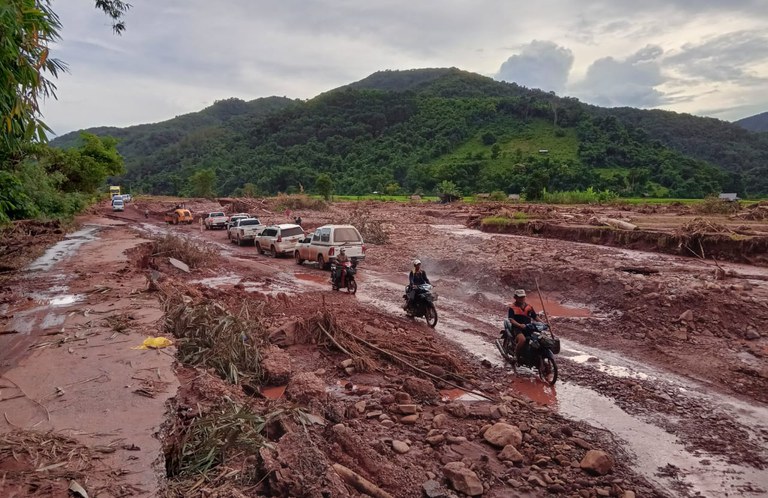Two weeks after tropical storm Ma-On battered Southeast Asia, northern Laos is digging itself out of the devastation, as authorities contend with damaged infrastructure, inundated farmland, and hundreds of displaced people at risk of disease from lack of access to clean water.
The ninth named storm of the 2022 Pacific monsoon season, Ma-On formed over the Pacific Ocean on Aug. 18 and became a severe tropical storm by Aug. 23, before slamming into Mainland Southeast Asia on Aug. 25. The storm brought heavy winds and rain to the region, and triggered flash floods in Vietnam and Laos.
While the storm had mostly dissipated by Aug. 26, its impact on impoverished Laos – with its limited capacity to rebuild in the aftermath of natural disasters – was profound.
Among the worst hit areas in northern Laos was Oudomxay province, where on Thursday, Provincial Governor Bounkhong Lachiemphone described the destruction as “massive” in an interview with the official Lao National Radio.
“The most devastated area is La district, followed by Nomor district and Xay district, where a lot of basic infrastructure such as roads, bridges, the power grid, hospitals, health clinics, schools, farms, and irrigation systems are damaged or destroyed,” he said.
“Our residents’ livelihoods are severely affected, especially in La district where more than 100 homes were swept away, and more than 500 others were damaged. Livestock are dead. Farmland – especially rice and produce fields – are covered with mud and debris.”

Bounkhong said damage from the storm in the three hardest hit districts had surpassed 150 billion Lao kip (U.S. $10 million) and that resources have been stretched thin as authorities continue with recovery efforts.
“Right now, we have employed 300 soldiers to help build shelters and repair damaged homes for the displaced,” he said.
“We’ve had to rely on donations from domestic and international organizations.”
Khamseng Ali, the head of the Public Works and Transportation Department of Oudomxay province, estimated that repairs to 49 roads and 44 bridges damaged in flooding caused by Ma-On would cost at least 60 billion Lao kip (U.S. $3.8 million).
“This is the worst flood in 37 years in our province,” he said.
An official with the Public Works and Transportation Department in Xay district, who spoke on condition of anonymity, told RFA Lao that National Route 13 North, which cuts across northern Oudomxay from the border with Luang Namtha province in the west to the border with Luang Prabang province in the east, had been severed in several places. Highway 2E, which runs from the capital of Oudomxay to the border with Phongsaly province to the northeast, is also damaged in multiple stretches as the result of landslides and flooding, he said.
“Many sections of the highways have become impassable,” he said, adding that recovery crews are “repairing them as we speak.”
Humanitarian efforts hampered
The devastation has severely hampered humanitarian efforts, according to health workers in the province, who told RFA that people displaced by the storm lack access to clean water and are vulnerable to disease.
“More than 1,000 people flocked to our hospital from Aug. 31 to Sept. 8,” said a health worker in Oudomxay’s Namor district.
“These sick people are from the 13 worst-affected villages … in Namor district. Most of them are children who are suffering from high fevers and diarrhea. Our health workers have also traveled to the affected villages and advised residents to only drink boiled water, eat thoroughly cooked food, sleep under mosquito nets, and wear masks.”
The health worker told RFA that many victims of the storm are also suffering from the flu, which has spread quickly within displaced communities.
“Our hospital spent 200 million kip (U.S. $12,700) to buy medicine, but much of it was damaged by flooding,” he said.
“Now, the hospital has run out of money and medicine, so we’ve had to request more funding from the provincial government.”
A resident of Namor’s Tangdoo village told RFA that there is no longer running water in the area and said at least 20 residents are sick from flu and diarrhea.
“Those whose toilets weren’t washed away by flooding must use water from wells or creeks to flush them,” said the resident, who declined to be named.
“When our village was flooded, there was a landslide too. The irrigation system is broken. Now we must fetch water for cooking and sewage.”

Displaced at risk
A health worker in Oudomxay’s La district told RFA that the flu is rampant.
“For treatment of flu, our district hospital and health centers in affected villages have run out of medicine,” the worker said.
“The sick who come to the hospital have to buy their own medicine at the private pharmacy. We haven’t received any additional funding for extra medicine despite the increasing demand.”
An official with the Oudomxay Provincial Health Department said authorities are scrambling to assist those in need, but acknowledged that recovery efforts are slow-going.
“Several areas were buried by landslides during the flooding and all of the water networks – including the irrigation systems – in Namor and La districts are damaged and in need of substantial repairs,” the official said.
Ma-On’s impact on northern Laos came days after authorities released water from nine upstream dams in the provinces of Phongsaly, Luang Prabang, Xayaburi, and Vientiane. Residents told RFA at the time that the release flooded their homes, places of work, and farms, forcing many to escape to higher ground.
Translated by Max Avary. Written in English by Joshua Lipes.

